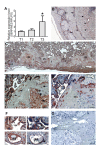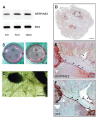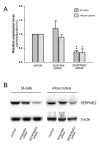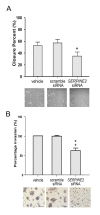Spatiotemporal expression of SERPINE2 in the human placenta and its role in extravillous trophoblast migration and invasion
- PMID: 21806836
- PMCID: PMC3161939
- DOI: 10.1186/1477-7827-9-106
Spatiotemporal expression of SERPINE2 in the human placenta and its role in extravillous trophoblast migration and invasion
Abstract
Background: SERPINE2, one of the potent serpins belonging to the plasminogen activator (PA) system, is involved in the tissue remodeling. We previously demonstrated the expression patterns of Serpine2 in the mouse placenta and uterus, indicating that Serpine2 is a major PA inhibitor in the placenta and uterus during the estrous cycle, pregnancy, and lactation. In this study, we further investigated the expression pattern of SERPINE2 in the human placenta and explored possible functional roles of SERPINE2 in regulating trophoblast activity.
Methods: Placental tissues from various trimesters were collected for real-time reverse-transcription polymerase chain reaction quantification. Immunohistochemical staining was performed in placental tissues to assure localization of SERPINE2. SERPINE2 small interfering (si) RNA was applied to suppress its expression in villous explants and extravillous trophoblast-like 3A cells. Subsequent experiments to evaluate SERPINE2 levels, villous outgrowth, trophoblast invasion, and tube formation were performed.
Results: SERPINE2 messenger RNA was detected in the human placenta during pregnancy with the highest levels in the third trimester. The SERPINE2 protein was present in villous syncytiotrophoblasts and trophoblasts of chorionic villi for anti-SERPINE2 immunostaining. Extravillous trophoblasts in the chorionic plate and basal plate confronting the invasive face of anchoring villi were also positive. In most decidual cells, SERPINE2 was observed in the cytoplasm. In addition, fibrinoid deposit was weakly immunoreactive. Introduction of SERPINE2 siRNA into villous explants and trophoblast cells led to significantly reduced villous outgrowth, and trophoblastic migration and invasion. Moreover, capillary-like network formation of 3A cells in Matrigel was greatly attenuated by SERPINE2 siRNA and SERPINE2 antiserum.
Conclusions: These data identify the temporal and spatial SERPINE2 distribution in the human placenta and suggest its possible role in modulating tissue remodeling of extravillous trophoblasts in the placenta during pregnancy.
Figures






Similar articles
-
Spatiotemporal expression of the serine protease inhibitor, SERPINE2, in the mouse placenta and uterus during the estrous cycle, pregnancy, and lactation.Reprod Biol Endocrinol. 2010 Oct 27;8:127. doi: 10.1186/1477-7827-8-127. Reprod Biol Endocrinol. 2010. PMID: 20977773 Free PMC article.
-
Dynamic changes in hyperglycosylated human chorionic gonadotrophin throughout the first trimester of pregnancy and its role in early placentation.Hum Reprod. 2015 May;30(5):1029-38. doi: 10.1093/humrep/dev016. Epub 2015 Mar 4. Hum Reprod. 2015. PMID: 25743784
-
Expression of Gadd45α in human early placenta and its role in trophoblast invasion.Placenta. 2014 Jun;35(6):370-7. doi: 10.1016/j.placenta.2014.03.020. Epub 2014 Apr 12. Placenta. 2014. PMID: 24755561
-
Spatial and temporal patterns of expression of messenger RNA for insulin-like growth factors and their binding proteins in the placenta of man and laboratory animals.Placenta. 2000 May;21(4):289-305. doi: 10.1053/plac.1999.0498. Placenta. 2000. PMID: 10833363 Review.
-
Maternal platelets at the first trimester maternal-placental interface - Small players with great impact on placenta development.Placenta. 2022 Jul;125:61-67. doi: 10.1016/j.placenta.2021.12.009. Epub 2021 Dec 9. Placenta. 2022. PMID: 34920861 Review.
Cited by
-
Comparison of extravillous trophoblast cells derived from human embryonic stem cells and from first trimester human placentas.Placenta. 2013 Jul;34(7):536-43. doi: 10.1016/j.placenta.2013.03.016. Epub 2013 Apr 28. Placenta. 2013. PMID: 23631809 Free PMC article.
-
Transcriptomic Changes Associated with Pregnancy in a Marsupial, the Gray Short-Tailed Opossum Monodelphis domestica.PLoS One. 2016 Sep 6;11(9):e0161608. doi: 10.1371/journal.pone.0161608. eCollection 2016. PLoS One. 2016. PMID: 27598793 Free PMC article.
-
Maternal Pre-Pregnancy Obesity Is Associated with Altered Placental Transcriptome.PLoS One. 2017 Jan 26;12(1):e0169223. doi: 10.1371/journal.pone.0169223. eCollection 2017. PLoS One. 2017. PMID: 28125591 Free PMC article. Clinical Trial.
-
Systemic inflammatory stimulation by microparticles derived from hypoxic trophoblast as a model for inflammatory response in preeclampsia.Am J Obstet Gynecol. 2012 Oct;207(4):337.e1-8. doi: 10.1016/j.ajog.2012.06.047. Epub 2012 Jun 29. Am J Obstet Gynecol. 2012. PMID: 23021701 Free PMC article.
-
Inhibition of the serine protease HtrA1 by SerpinE2 suggests an extracellular proteolytic pathway in the control of neural crest migration.Elife. 2024 Apr 18;12:RP91864. doi: 10.7554/eLife.91864. Elife. 2024. PMID: 38634469 Free PMC article.
References
Publication types
MeSH terms
Substances
LinkOut - more resources
Full Text Sources
Miscellaneous

